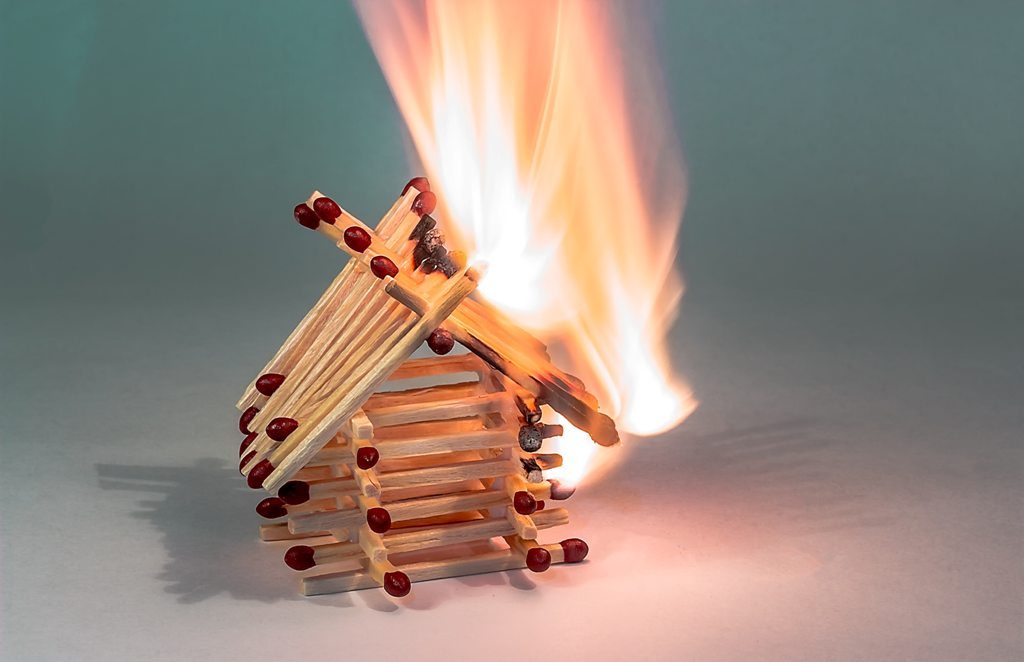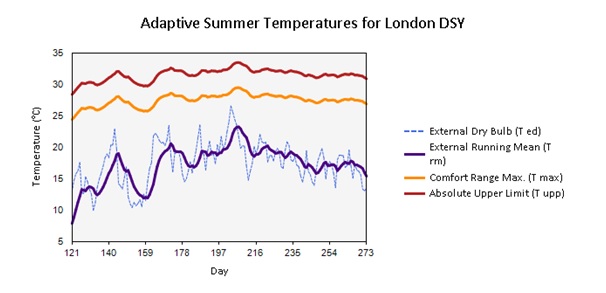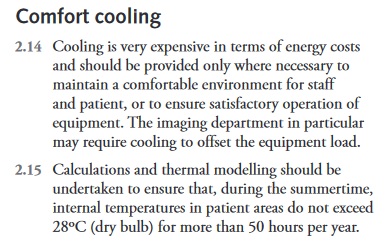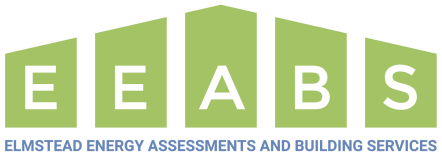With Climate Change and the Urban Heat Island effect causing summer time temperatures to increase year on year, overheating within our homes and places of work is quickly becoming a problem in building design that needs to be addressed.
 At Elmstead Energy Assessments and Building Services we can create a Dynamic Simulation Thermal Model of your proposed or existing building and accurately input its internal heat gains such as occupants, lighting and equipment.
At Elmstead Energy Assessments and Building Services we can create a Dynamic Simulation Thermal Model of your proposed or existing building and accurately input its internal heat gains such as occupants, lighting and equipment.
We will also model any windows, louvres or shading devices and then use actual weather data for the location of your building to simulate its amount of overheating throughout a typically hot Design Summer Year (DSY).
The overheating results we produce can then be compared against the relevant standards for your type of building such as BB 101 2018 for Schools, CIBSE TM 52 for Offices, CIBSE TM59 for Dwellings or Care Homes, and HTM 03-01 for Healthcare Premises, to determine if they would satisfy the regulations and not overheat.
If any rooms are found to be overheating, then alternative design strategies such as increased window openings, lower window G-Values or night time cooling can be quickly simulated and the results compared.
Any room still suffering from overheating may then require mechanically cooling in order to keep its internal temperatures at a comfortable level. If this is the case, we can also carry out the Peak Cooling Load calculations you would require to size the cooling system.
You can learn more about the different types of Overheating Assessments we can carry out below:
CIBSE TM 52 is the latest guidance for overheating in non-domestic buildings. The TM 52 calculation uses the CIBSE DSY (Design Summer Year) weather files which are selected from a 30-year baseline 1984 – 2013.
There are 3 separate DSY weather files available which represent different types of hot summers.
- DSY1: Moderately Warm Summer
- DSY2: Short, Intense Warm Spell
- DSY3: Long, Less Intense Warm Spell
The DSY1 weather data is used to show compliance with TM52, DSY2 and DSY3 are used to explore further scenarios and how the building would react to these.
The CIBSE TM52 calculation is an adaptive overheating calculation meaning that the ideal comfort temperature inside a building will be related to the outdoor air temperature.
Whereas other overheating calculations such as CIBSE Guide A suggest a fixed upper limit of 28°C that cannot be exceeded for 1% of the occupied time, TM52 has an adaptive comfort temperature limit that responds to the outdoor temperature at that time.

CIBSE TM52 has 3 criteria to assess the level of overheating and it must pass 2 of the 3 to pass the guidance overall.
The TM52 overheating compliance criteria is as follows;
Criterion 1: Hours of Exceedance – The number of hours during which ∆T is greater than or equal to one degree (K) during the period May to September inclusive shall not be more than 3% of the occupied hours.
Criterion 2: Daily Weighted Exceedance – To allow for the severity of overheating the weighted exceedance shall be less than or equal to 6 in any one day.
Criterion 3: Upper Limit Temperature – To set an absolute maximum value for the indoor operative temperature the value of ∆T shall not exceed 4K.
CIBSE TM59 Design Methodology for the Assessment of Overheating Risk in Homes takes influence from the CIBSE TM52 overheating guidelines and provides a set of criteria that determines whether a dwelling will suffer from overheating.
Criterion 1: For Living Rooms, Kitchens and Bedrooms – The number of hours during which ∆T is greater than or equal to one degree (K) during the period May to September inclusive shall not be more than 3% of the occupied hours.
Criterion 2: For Bedrooms Only – The operative temperature from 10pm to 7am shall not exceed 26°C for more than 1% of annual hours (32.85 hours).
Bedrooms must pass both criteria in order to satisfy the CIBSE TM59 Overheating Assessment.
Although there are no current compulsory building regulations surrounding the overheating of new homes, this is expected to change with the updated release of the Part L Regulations in 2019.
CIBSE TM59 Overheating Assessments are already required in new dwellings within London as part of a London Plan Energy Assessment, and the rest of the country is expected to follow soon.
We have written more in-depth information about CIBSE TM59 here.
The new Building Bulletin 101 2018 – Guidelines on Ventilation, Thermal Comfort and Indoor Air Quality in Schools, states that free-running (naturally ventilated) schools should carry out an overheating risk assessment in accordance with the CIBSE TM52 methodology but with slightly different compliance criteria.
The overheating risk assessment is carried out for the hours of 9am to 4pm (with a lunchbreak between 12pm to 1pm), Monday to Friday, from 1st May to 30th September. The summer holiday period is included as if the school was occupied normally.
As with CIBSE TM52 there are 3 criteria to the overheating assessment, however only criteria 1 is a minimum requirement to pass in order to satisfy the BB 101 2018 guidelines. Criteria 2 and 3 need to be carried out but only need to be shown for information only and to inform the design.
The BB 101 2018 overheating criteria are:
Criterion 1: Hours of Exceedance – For schools, the number of hours during which ∆T is greater than or equal to one degree (K) during the period 1stMay to 30thSeptember for the defined hours inclusive shall not be more than 40 hours.
Criterion 2: Daily Weighted Exceedance – To allow for the severity of overheating the weighted exceedance shall be less than or equal to 6 in any one day.
Criterion 3: Upper Limit Temperature – To set an absolute maximum value for the indoor operative temperature the value of ∆T shall not exceed 4K.
Health Technical Memorandum 03-01 is produced by the Department of Health and provides guidance on the Specialised Ventilation requirements for Healthcare Premises such as Hospitals, Doctors Surgeries and Healthcare Centres.
The guidance states that thermal modelling should be undertaken to ensure that internal temperatures in patient areas do not exceed 28°C (dry bulb) for more than 50 hours per year.

How we can Help
At Elmstead Energy Assessments and Building Services we have years of experience in carry out overheating assessments on a range of building types such as schools, offices, and dwellings.
We can use of proficiency in Dynamic Simulation Modelling to investigate different building designs quickly and compare their overheating results.
If you need an overheating assessment carried out to satisfy BB 101 2018, for achieve BREEAM credits or as part of a London Plan Energy Assessment, contact us today.


